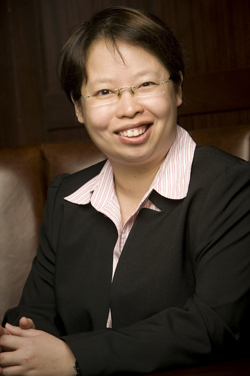Mixed Media
TC doctoral student Susan Choo is taking a visual approach to language and literacy
To TC doctoral student Susan Choo, a picture is worth a thousand words—it can help people learn many of them, too.
Choo’s interest is in teaching English to high school students who have yet to master it. The word that summarizes her approach is “multimodal.” To Choo, it’s a fancy word for a simple idea: Instead of just focusing on kids learning words, a teacher mixes in other “modes,” namely visual things like photographs.
How does it all work? In the spring, Choo, who is a pursuing a Ph.D. in English Education, headed to a class at Newcomers High School in Queens, which serves new immigrants whose English is at best a work in progress, and set out to teach a 10-week visual literacy curriculum she created.
The curriculum, Writing Through Visual Thinking, uses newspapers as a key to learning. Newspapers are by nature “multimodal,” Choo says, because they are both text- and image-driven. Thus, they were a perfect tool to get the immigrant students at Newcomers High to begin looking analytically at photos of current events, such as last winter’s dramatic plane crash and rescue in the Hudson River or the inauguration of President Obama, and discussing how they relate to the accompanying article.
“A lot of these kids never saw the link between visual and print modalities before; they were never taught to see it,” Choo says. Over the course of the 10 weeks, she helped the students to delve beyond the two-dimensional photo on a newspaper’s front page to grasp the techniques the photographer used: layering, perspective, tone and detail. Students then transferred these same techniques to analyzing the print text.
“The visual text was a platform used to make the print text more accessible to them,” Choo says. “Many of these students find reading very difficult. When we teach students to analyze photos or graphics, they can begin to understand the print text in a deeper way, not just what it says but how it has been constructed and for what purpose.”
The curriculum actually grew out of a similar project Choo spearheaded as a curriculum consultant to a secondary school in her native Singapore Singapore and, she says, it worked in Queens , with her students developing not only their language skills, but critical and analytical thinking skills as well. Choo has found the approach particularly effective given that young people the world over live in image- and media-saturated societies.
Choo’s interest in multimodal approaches is not new. As a lecturer at Nanyang Technological University (NTU) in Singapore England , Canada and Australia
Perhaps not surprisingly, after completing her studies at TC, Choo plans to return to Singapore
“I was surprised when I came to the United States that no such curriculum existed here, even though America
Published Tuesday, Nov. 24, 2009
